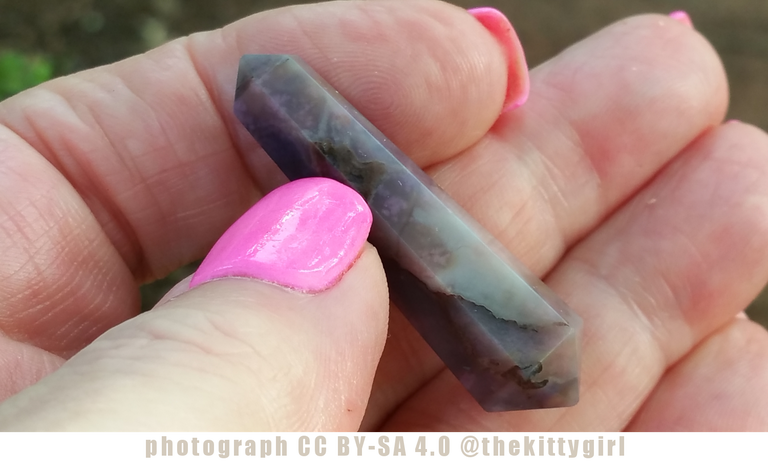Pietersite
What do you get when you cross a hawk with a tiger? Read on to find out!
This simple-looking stone has a rather complicated geological history. So, please, bear with me as we explore the nuances of this fascinating rock and learn the answer to the above question.


Sometimes, however, crystals form in such tiny structures that they cannot be seen with the naked eye, and those are referred to as "microcrystalline" structures. Others are so small that they are not even discernible in a typical microscope, and those are called "cryptocrystalline" structures. Such is the case with this stone, but it gets even more interesting...

One mineral I have not written about yet is crocidolite, a family of minerals that includes Tiger's Eye, Hawk's Eye, and others. Crocidolite is a mineral that forms in long fibers which can reflect flashes of light. This stone was once composed of crocidolite fibers, but over time that crocidolite was replaced by quartz.
So, this rock was once crocidolite — both Tiger's Eye and Hawk's Eye varieties, swirled together — which was then replaced by cryptocrystalline quartz (which is known as "chalcedony") so, it is now a brecciated chalcedony. The particular variety of brecciated chalcedony was first discovered by Sid Pieters, so it is named Pietersite, in his honor.
If that isn't an interesting story behind a rock, I don't know what is!


I did not know anything about this mineral when I got the sample I have. I just saw it in a shop, thought it was pretty, and recognized it as something I did not already have in my collection. After reading about its rarity, I am thrilled now, in hindsight, to have had the opportunity to purchase it! As with many of my mineral specimens I obtained long ago, I do not remember what I paid for it, but I am sure it was less than USD $15, maybe even around USD $10, and probably 18 years ago or more.
FireMountainGems says "Because its swirling colors resemble a storm, pietersite is known as tempest stone." So, this is like holding a storm in the palm of one's hand! 😁
 😊
😊SOURCES
1 FireMountainGems.com: Pietersite
2 Wikipedia: Agate
3 Wikipedia: Chalcedony
4 Wikipedia: Cryptocrystalline
5 Wikipedia: Tiger's Eye





to learn more about either of these projects, please visit: @heyhaveyamet or @theterminal

28-Sep-2020
View or trade
BEER.Hey @thekittygirl, here is a little bit of
BEERfrom @pixresteemer for you. Enjoy it!Learn how to earn FREE BEER each day by staking your
BEER.Very interesting. Everytime I am in some gift shop for instance when I was traveling around the states and on state parks I would be drawn towards the rocks and crystals. Fascinating and beautiful created over such long periods of time. Cool shit. You ROCK! or Crystal. What would the correct phrase be?
This is one of my favourite stones! Got to put them on quite often! Giver of energy for me! Like a turbo charge to my lazy energy! LoL
GREAT POST!!!
Thank you for publishing it to our community feed!
Compliments of the PHC founder @jaynie...
We have tweeted, upvoted and reblogged it for you.
❤ MWAH!!! ❤
JOIN OUR DISCORD COMMUNITY
SUBSCRIBE TO OUR COMMUNITY FEED
FOLLOW US ON TWITTER
https://twitter.com/phccommunity/status/1310568191530356736
LOL!!!!!! - Seeing as you asked so nicely!
Well damn! That is indeed quite a story. Any idea of its "energetic properties"? No doubt those would be pretty interesting too.
!tip
🎁 Hi @thekittygirl! You have received 0.1 HIVE tip from @jaynie!
@jaynie wrote lately about: Comment To Win! Feel free to follow @jaynie if you like it :)
Sending tips with @tipU - how to guide.
an interesting post, take a good care of yourself. God bless you ❤️❤️❤️❤️😊😍
This post has received a 100.00% upvote from @fambalam! Join thealliance community to get whitelisted for delegation to this community service.
I'm not familiar with this stone, but it reminds of my years in Colorado, where every town has it's own gem and rock store, something not so common in all states.